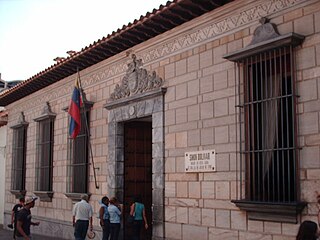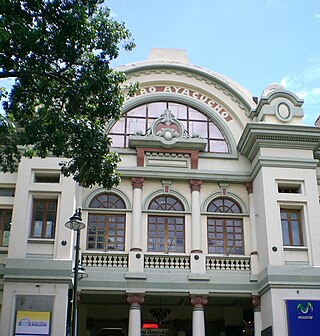Self-guided Sightseeing Tour #2 in Caracas, Venezuela
Legend
Guided Free Walking Tours
Book free guided walking tours in Caracas.
Guided Sightseeing Tours
Book guided sightseeing tours and activities in Caracas.
Tour Facts
4.6 km
136 m
Experience Caracas in Venezuela in a whole new way with our free self-guided sightseeing tour. This site not only offers you practical information and insider tips, but also a rich variety of activities and sights you shouldn't miss. Whether you love art and culture, want to explore historical sites or simply want to experience the vibrant atmosphere of a lively city - you'll find everything you need for your personal adventure here.
Activities in CaracasIndividual Sights in CaracasSight 1: Cuartel San Carlos

The San Carlos Barracks is a colonial military building in Caracas, Venezuela; today converted into a National Historic Monument. It is located between the corners of Dos Pilitas and Cuartel San Carlos in the Altagracia Parish of the Libertador Municipality.
Sight 2: Mausoleo al Libertador
Sight 3: National Pantheon
The National Pantheon of Venezuela is a final resting place for national heroes. The Pantheon was created in the 1870s on the site of the ruined Santísima Trinidad church from 1744 on the northern edge of the old town of Caracas, Venezuela.
Sight 4: Iglesia Santa Capilla
The Basilica of Santa Capilla It is a Roman Catholic basilica in Caracas, Venezuela located at the corner of Santa Capilla on Avenida Urdaneta. It is located in the historic center of the city, in the Cathedral Parish of Libertador Municipality. On February 16, 1979 was declared a National Historic Landmark.
Sight 5: Teatro Principal de Caracas
The main theater of Caracas is a space dedicated to the representation of operas, musical shows, cultural and plays. It is located in the historic center of the city of Caracas, Venezuela, specifically in the adjacencies of the Plaza Bolívar. It was inaugurated on April 18, 1931, being a work of the architect Gustavo Wallis Legórburu. In his time it was the first building in Venezuela that had a steel frame, front balcony and an acoustic treatment on the walls. It was also the second main cinema of the capital city with 760 seats for the public. In May 1935, the legendary Carlos Gardel offered one of his last performances since he would perish a month later on June 24 in Medellín (Colombia). Since then, this space is recognized by the Caracas as a symbolic site of the tango and the theater. In 1953 he was remodeled, which caused part of the Art Deco interior decoration. In 1990 it became a Mexican film room. It remained closed for several years until it was reopened in July 2011, within the framework of the Bicentennial of the Independence of Venezuela. This theater was reopened by the Government of the Capital District (GDC) and the Mayor's Office of Caracas, after a facade restoration process, lobby, monumental lighting, elevator, tramoya and scene. It has 710 seats, distributed in patio, 465; First balcony, 123; and second balcony, 122. This remodeling was not an isolated event, but was part of the recovery of the historic center of Caracas undertaken during the Hugo Chávez government that rescued old theaters, movie theaters and historical houses that had ended as commercial spaces Like shoe stores. The headquarters of Caracas and the District Theater Company are currently operating on it.
Sight 6: Catedral de Caracas

The Caracas Cathedral or Metropolitan Cathedral of Saint Anne is the seat of the Roman Catholic Metropolitan archdiocese of Caracas, located on the Plaza Bolívar in Caracas, Venezuela. Its chapel of the Holy Trinity is the burial site of the parents and wife of Simón Bolívar. The Nuestra Senora de Venezuela y Santa Ana is a square (cuadra) situated between the cathedral and the central plaza, which is walled on three sides, but open to the east where it faces the cathedral.
Sight 7: Casa del Vínculo y del Retorno
The House of the Link and Return is a mid-eighteenth-century building linked to the process of Independence of Venezuela. It is located on the corner of Gradillas, one of the corners of Plaza Bolívar, in downtown Caracas.
Sight 8: Casa Natal del Libertador
The Birthplace of Simón Bolívar is a seventeenth-century house in the Venezuelan capital city Caracas where the hero of Venezuelan and Latin American independence, Simón Bolívar, was born. Now a significant tourist attraction, the building is located in a little street off the Plaza San Jacinto, a block east of the Plaza Bolívar. It is one of only a few houses from the colonial era which survive in central Caracas.
Sight 9: Iglesia de San Francisco

Iglesia de San Francisco is a church in Caracas, Venezuela. Dedicated to Francis of Assisi, it was built in 1593 under the design of Antonio Ruiz Ullán as an annex of the Convent of San Francisco. The church is notable as being the situ where Simón Bolívar received the title "El Libertador" (1813). His funeral occurred here in 1842. During the 1900 San Narciso earthquake, the church was severely damaged.
Sight 10: Teatro Ayacucho
The Ayacucho Theatre or Teatro Ayacucho is a cinema located in central Caracas, specifically in the Libertador Municipality parish in the west of the Caracas metropolitan district.
Sight 11: Teatro Junín
The Junín Theater is a publicly owned theater located in the central part of the city of Caracas, specifically in the vicinity of Plaza O'Leary in the Libertador Municipality west of the metropolitan district of Caracas, in northern Venezuela.
Sight 12: Plaza O'Leary

O'Leary Square is a public space in Caracas, Venezuela. It is located in the central area of that city, in the El Silencio Redevelopment of the Cathedral Parish of the Libertador Municipality; specifically between Bolívar, Sucre and San Martín avenues, a point known as the "Y". Its name is due to the Irishman Daniel O'Leary, who fought in the Venezuelan independence army along with Simón Bolívar, Antonio José de Sucre and José Antonio Páez.
Sight 13: Arco de la Federación
The Arch of the Federation is a monument located in the Libertador municipality, west of the metropolitan district of Caracas, Venezuela; specifically located within the Ezequiel Zamora Park, in the center-west of the capital. It is colonial in style.
Sight 14: Parque El Calvario

Ezequiel Zamora Park, also known throughout its history as Paseo Guzmán Blanco - Paseo Independencia - Parque El Calvario - El Calvario, is a public space in Caracas, Venezuela located in the central part of that city west of the El Silencio Redevelopment, between the Catedral and San Juan parishes of the Libertador Municipality. It has an area of 17 hectares that occupy green areas, gardens, monuments and squares.
Share
How likely are you to recommend us?
Disclaimer Please be aware of your surroundings and do not enter private property. We are not liable for any damages that occur during the tours.
GPX-Download For navigation apps and GPS devices you can download the tour as a GPX file.







